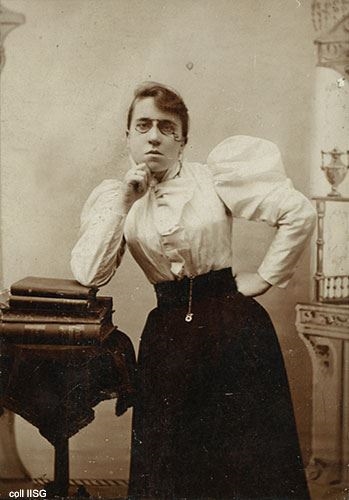 |
| Emma Goldman (1869 - 1940) (http://www.iisg.nl/collections/goldman/images/a5-483.jpg) |
There are a few people who really impress me with their courage. One of them would have to be Emma Goldman. She was not just a brave individual--she chose to live her entire life out as an almost universally hated woman, except by the minority of Anarchists that worshipped her as a High Priestress figure. Rather than sulk or "play the victim," she reeled against the adversity that she was forced to endure and clung fiercely to her belief of free speech, free love, and equality. Once dubbed "The Most Dangerous Woman in America," to many, she was the spitting image of a terrorist who despised the United States and wished to see it transformed into an Anarchist wasteland. But, on the contrary, Goldman was a human woman with legitimate emotions who loved her country dearly. She believed in the American dream and was not afraid to attempt to make the country live up to its promises. The outcome of her life is indeed tragic and underserving of a woman with her exceptional bravery.
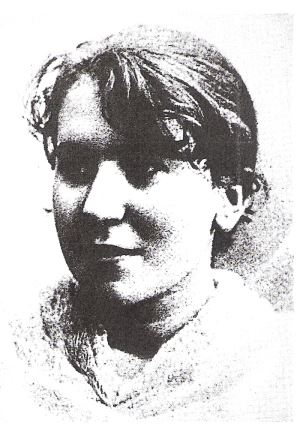 |
| A teenage Emma Goldman (http://cookingwiththejuniorleague.files.wordpress.com/2009/09/teenage-emma-goldman.jpg) |
The fierce and feisty daughter of a Russian peasant, she escaped a loveless marriage by threatening suicide, and escaped the tyranny of the Tsarist Russian Empire by emigrating to the United States of America. Upon arrival, she experienced a failed marriage and gained first-hand experience of American nativism and prejudice from her work in the urban factories. The realities of capitalism in the American system, which contradicted the popular expectations held by many immigrants from Europe, drew Goldman to the Anarchist philosophy, which emphasized order without law, free love, and equality. Goldman became influenced by the libertarian writings and speeches of Anarchist Johann Most, and she became an Anarchist, herself. Working closely with her close confidant and lover, Alexander Berkman, Goldman became active in the trade union movement.
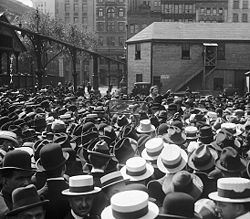 |
| Emma Goldman addressing a crowd (http://wpcontent.answers.com/wikipedia/commons/thumb/5/5c/Emma_Goldman_surrounded_by_crowd.jpg/250px-Emma_Goldman_surrounded_by_crowd.jpg) |
In 1892, Goldman made the mistake of aiding Berkman in the attempted, premeditated assassination of Industrialist Henry Clay Frick, following the infamous Homestead Lockout in Pennsylvania. The assassination was meant to rally all working people to overthrow the Capitalist system in the United States. However, the plan failed miserably and Berkman was sent to prison. Goldman would be led to rethink her position on the practicality of violence as a solution to people's problems, and would publicly regret her decision to help Berkman. A year later, however, during the outbreak of the 1893 Depression, in which thousands, perhaps millions, of Americans were put out of work, Goldman herself was arrested. She had been arrested for addressing a crowd of working people, invoking them to go to the city bakeries and restaurants and "ask for work." "If they do not give you work, or bread," she instructed, "then take the bread." Goldman spent a year on Blackwell's Island before being released. Although she stated that she had been arrested for merely "talking," she continued to do just that, only louder.
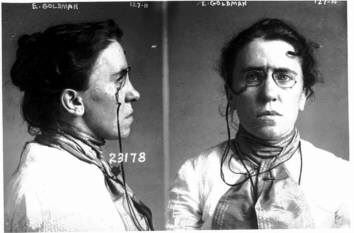 |
| Emma Goldman 1901 mugshot (http://www.noonewatching.com/archives/2006/12/emma1.jpg) |
After she was released from prison, Goldman travelled the country speaking publicly about the Anarchist philosophy. One of her speeches was heard by a young man named Leon Czolgosz, who claimed that her speech had "set him on fire." Czolgosz would proceed to stalk and eventually assassinate President William McKinley at the Pan American Exposition in New York, in 1901, claiming that he was the enemy of the working individual. When the authorities heard of Goldman's potential involvement in the crime from Czolgosz, they abruptly stormed her hotel room and interred her in prison, along with a large group of her fellow Anarchists. Goldman was treated coarsely, and even violently, by the authorities, who denied her basic comforts, yelled at her rudely, and opened her mail. Upon being forced into a paddy-wagon after her arrest, Goldman had one of her teeth knocked out for protesting the ill treatment of another prisoner. Goldman proved to be innocent of any involvement, much to the disappointment of the country, which had wanted her dead from the moment her involvement was suspected. But Goldman further horrified the American public when she threw herself into an impassioned defense of Czolgosz, claiming that she was principally against violence and murder, but that the conditions of urban America were producing murderers, and that Czolgosz was being treated unfairly on the basis of his beliefs. Despite the fact that Czogolsz was responsible for her arrest and degradation, Goldman was one of the only individuals to stand up in defense of the assassin, as even the Anarchist leaders backed away from defending him. I deem this act to be truly courageous.
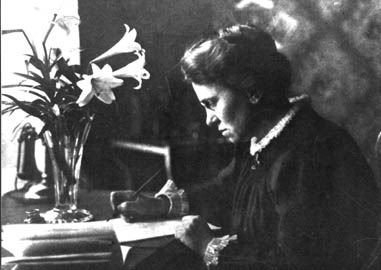 |
| Goldman at her desk (http://2.bp.blogspot.com/_CBQ4u_Uuc2o/Sgdmbk0Cu3I/AAAAAAAAAV0/wekFTOu-9QI/s400/emma_goldman_3.jpg) |
Goldman continued to publicly advocate for women's rights and birth control as the years went by, taking a young Margaret Sanger under her wing, and she was imprisoned for two years for her distribution of birth control literature. She became especially outspoken during the American entrance into World War I, in which she declared herself a Pacifist and helped in the formation of the No Conscription League. She and Berkman organized mass demonstrations in defiance of the military draft. Goldman was, predictably, arrested promptly, on charges of conspiracy to avoid the military draft. At her trial, however, she pointed out the ludicrous nature of her imprisonment, as American lives were being lost to preserve free speech, and yet it was suppressed in the United States. Nonetheless, she spent two years in prison. During her imprisonment, much to her own personal joy, the Russian Revolution occurred, and the once-Empire was now controlled by the working people; the Bolsheviks, the Mensheviks, and the Anarchists. Although Goldman and her colleagues were overjoyed, the American public was mortified. Attorney General A. Mitchell Palmer led, in 1919, his infamous "Palmer Raids" in which 10,000 suspected Socialists, many immigrants, were arrested for their beliefs. Immigrants found guilty were deported. Among them was Goldman, and her lover, Alexander Berkman, who were perceived as too dangerous to be allowed to stay in the country. Along with 246 other people, they were deported to Russia. Although Goldman feigned bravery and smugly declared that she was proud, privately, she was devastated and heartbroken. America had been her home for over thirty years, and she could not bear to leave the country she loved so dearly. Regardless, she and her lover were hopeful for the new possibilities presented by the Russian Revolution.
However, Goldman and Berkman became disillusioned by the realities of the Revolution's failures, and they balked at the starvation and atrocities they saw at the hands of the Bolsheviks. A private audience with Vladimir Lenin did nothing to explain the harsh contradictions between Goldman's philosophy and the Revolution's realities. She managed to obtain British citizenship by marriage and fled Russia, and later moved to France, devoting her life to reversing the positive image held by Socialists and Anarchists about the Bolshevik Revolutionaries by means of public speaking and literature. Her books helped to turn a large number of socialists against the Bolshevik government. Goldman's life continued to be relevant to the Communist-Socialist challenge in the world. She visited Spain in September of 1936 to observe the Spanish Civil War. She met with leading figures in the National Confederation of Trabajo (CNT) and Federación Anarquista Ibérica (FAI). She helped to establish the Committee to Aid Homeless Spanish Women and Children. However, despite Goldman's commitment to fighting Communism, the country stood by its decision to allow Goldman to remain in exile, and she was only permitted entry into the country on one occasion, for a brief period. Emma Goldman was in Toronto when she died on 14th May 1940. The USA government decided to give permission for her body to be buried in Chicago.
I admire Emma Goldman in a unique way that I admire few people in American History. She was strong in that she recognized her mistakes in life and sought to reverse them. She realized that aiding Alexander Berkman in attempting to assassinate Henry Clay Frick was a mistake, and she devoted her life to preaching non-violence. She realized her support of the Russian Revolution was misguided, and so she devoted herself to combating the Communist influence. In her mind, it was only the individual who could enact positive social change, and she cared little about what either her admirers or her enemies thought about her. Goldman deserved better over the course of her life, than to have been so violently detested by the entire country. She could not change who she was or what she believed in, and she saw no sense in hiding what she was from the rest of the world. For that, Goldman was hounded and persecuted for most of her life, but she always handled it with the grace and nobility of a heroine. And, although Goldman's dreams of equality and fairness in society seemed far-fetched and hopeless in her own time period, she would be pleased to see how American society has changed to benefit the poor, the ill, and immigrants by means of reform.
Page created on 7/1/2010 12:00:00 AM
Last edited 7/1/2010 12:00:00 AM
Bly, Nelly. "Emma Goldman: Nelly Bly Again." American Experience.
Goldman, Emma. Living My Life . 1931.
Bucklin, Mel. "American Experience: Emma Goldman. "2004.
Unknown, Author. Emma Goldman: Biography.
Johns, A. Wesley. The Man Who Shot McKinley.

The was my ideal of her, I confess, and when the matron stood before me saying, "This is Emma Goldman," I gasped in surprise and then laughed.
A little bit of a girl, just 5 feet high, 2 including her bootheels, not showing her 120 pounds; with a saucy, turned-up nose and very expressive blue-gray eyes that gazed inquiringly at me through shell-rimmed glasses was Emma Goldman!"
- Nelly Bly, The New York World , 17 September 1893, pp. 1, 3.